Etsy DropShipping: The ultimate guide for DropShipping on Etsy
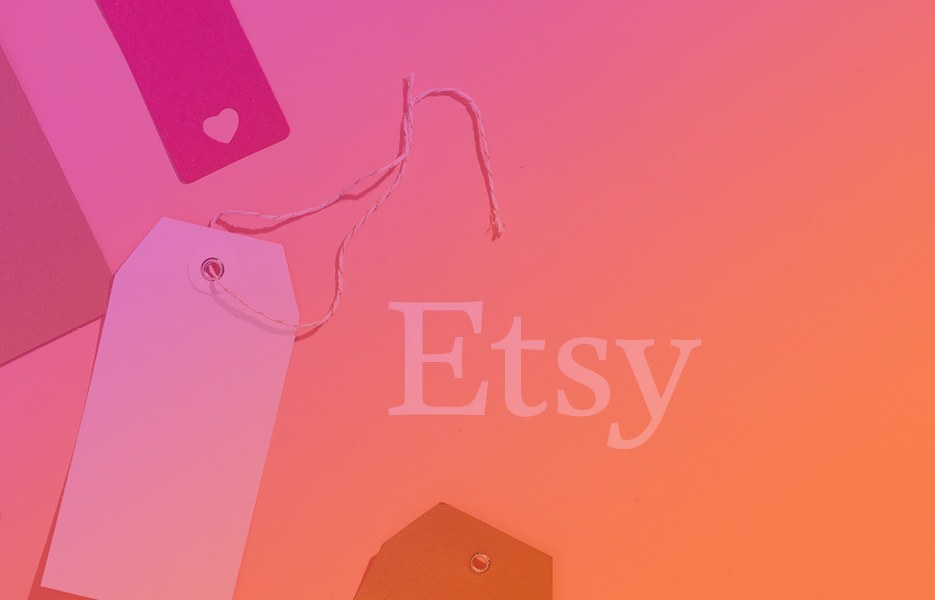
What is Etsy?
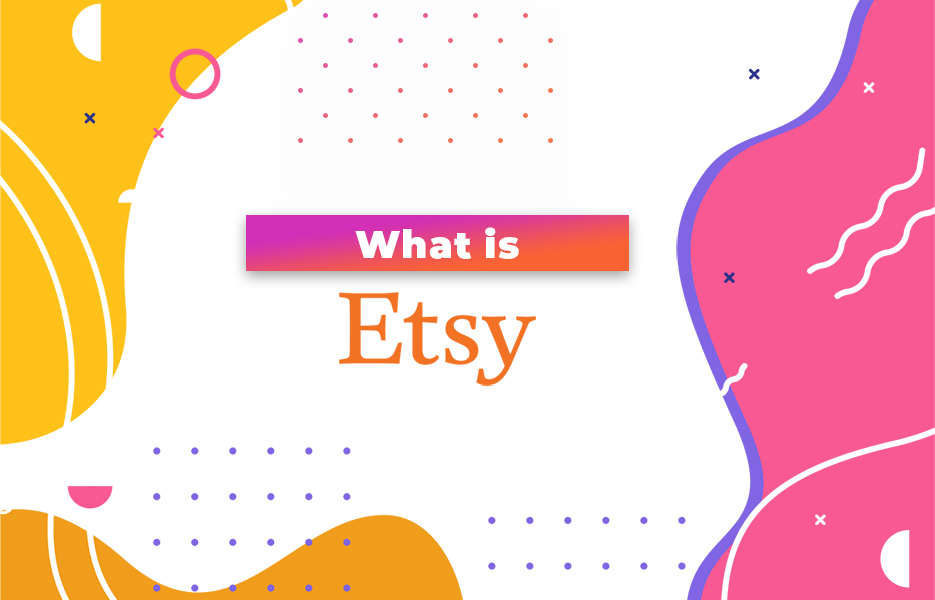
Etsy is a marketplace that sellers who create handmade, vintage or crafted items can sell their items. Customers head for Etsy when they’re looking for something unique, and that they are unlikely to find anywhere else. Etsy was launched in 2005, so it’s been around for quite some time – and during that time, Etsy customers have increased dramatically – from 9.3 million in 2012 to over 40 million in 2019, from 83 countries worldwide.
There are over 60 million products listed on Etsy, from over 2.6 million sellers. Compare that to over 353 million items on Amazon, and it’s clear why sellers that qualify might want to list their items on Etsy – it’s a lot easier to get your products in front of customers who are looking for them! As a sales channel, Etsy also enjoys great brand awareness – since dramatic changes were made to the company in 2018, the company has been working on increasing brand awareness, with TV and media campaigns to raise the profile of the marketplace.
What is DropShipping?
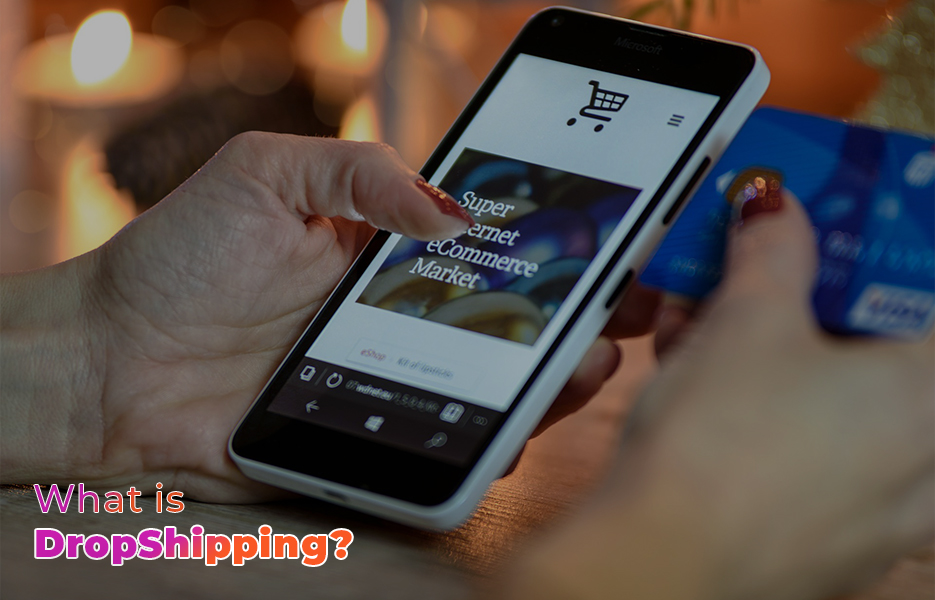
Before we get going discussing DropShipping on Etsy specifically, let’s take a quick look at DropShipping generally. Let’s use our shortest definition of what DropShipping is here:
DropShipping is a direct to consumer retail fulfilment method where a seller does not hold stock.
To put that in plainer English and explain a little more, here is how DropShipping works: When a customer places an order with a seller on an eCommerce website, an online marketplace or in-store, the seller immediately sends the order information, payment for the order, as well as a fee to a supplier. The supplier then takes care of picking, packing and dispatching the items in the order directly to the customer.
The seller may or may not hold their own stock. Sellers might have their own store, either on the high street, or they might have a small warehouse and are using DropShipping to help them scale their business up (many Avasam sellers use DropShipping in this way) or they might be purely selling using the DropShipping model.
Where orders are being sent by a DropShipping supplier, the seller does not see the items in the order, or have anything to do with the delivery of the order. The customer is unlikely to know – or care – that the seller is DropShipping their order. Customers are generally more concerned whether their order is the right price, and arrives when they want, or need it.
Of course, it might not be as simple as we’ve made it sound here. A customer might order a number of items from the same seller, and those items come from different suppliers. It’s up to the seller to make sure the right order information makes it to the right supplier for processing. There might be complications around shipping products of different sizes, and so more than one shipping provider has to be used. If there are multiple suppliers required to fulfil an order, there may be complications. And that’s before we consider if there are items that need to be returned or refunded.
Despite the fact that DropShipping isn’t always straightforward, some high street retailers are using DropShipping as a way to extend their product range for customers, without needing to invest in stock or storage space. Since DropShipping is so flexible, high street retailers can extend that flexibility to their customers too. Retailers can decide whether to have items sent directly to customers, or they can have items delivered to the store to encourage high street footfall – which as the media has reported, is dramatically in decline. Customers who prefer not to shop online (for whatever reason) can benefit from access to additional product ranges, and sellers are able to provide access to those items at a lower price than if they were bulk buying, and storing the products.
Benefits of DropShipping items from Etsy
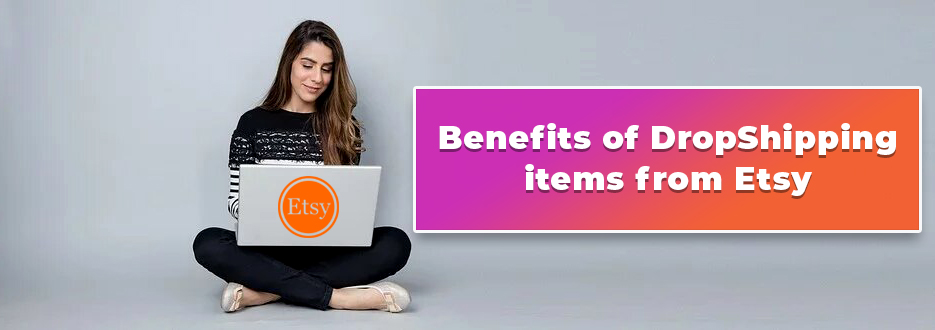
Whatever your business setup, if you are DropShipping and are looking for products that are a bit different from your competitors, then you might think of using Etsy as a source of new, and unique products that can help to keep your customers interested. There are a few reasons that you might decide to do this.
Etsy sellers have unique products
If you’re looking for one-off, or premium handmade products, Etsy can be a great place to find them. Because items being sold on Etsy are made by hand, even with the items that are the easiest to make, there simply can’t, and won’t be as many of those items available as commercially made products. That makes them that bit more special – especially for items like jewellery, or items for use at memorable occasions like weddings. Since there are over 60 million items for sale on the platform, that’s plenty of opportunities to keep your customers coming back for more. And because those items are that bit more bespoke – they’re one-off items in many cases – customers are often prepared to pay that little extra for them.
Etsy products suit particular niches
Handmade goods, baby products, wedding and party products… Etsy is the place to find great bespoke items for customers in certain niches. If you’re already selling these kinds of products, you can potentially make sales by DropShipping handmade items from Etsy. We recommend listing these kinds of items alongside your other items, perhaps as a ‘premium’ range – allowing you to capitalise on the bespoke nature of the products.
Massive choice of sellers
Etsy has a huge number of sellers on the marketplace, with over 2.6 million active sellers currently on the platform. That number is growing too – meaning there are more and more chances that you will find the sort of product you are looking for.
Challenges of DropShipping items from Etsy
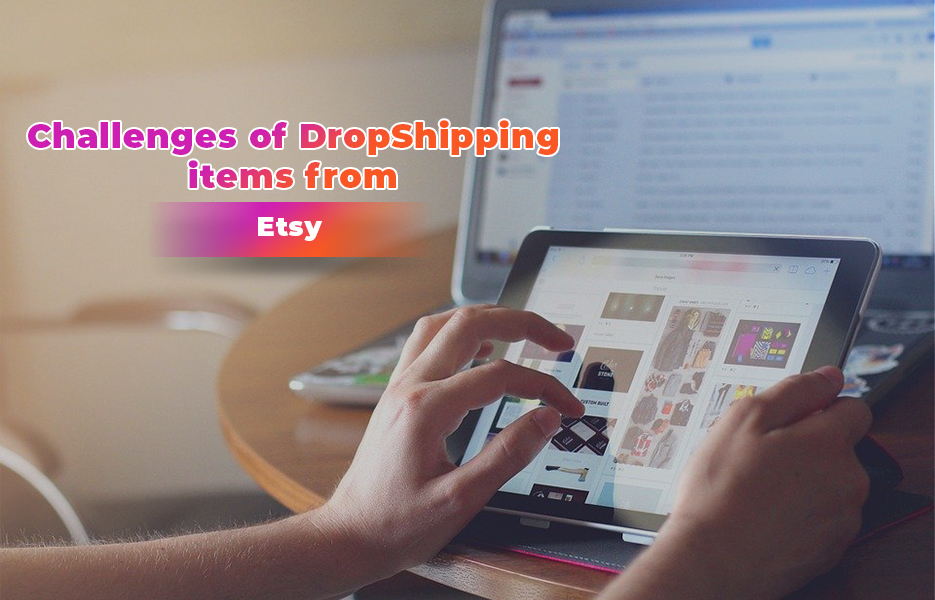
While there are good reasons to use Etsy to source items for your DropShipping business, there are some major hurdles that you might encounter – not least, because prices of products on Etsy can be much higher than you expect. Let’s find out more.
Items selling on Etsy are above retail value – because they are unique
When browsing items available for sale on Etsy, you might notice that prices are much higher than if you were looking for the same item on eBay or Amazon. It makes sense, when you think about it – the seller is producing each item, and they need to be able to pay themselves for their time, on top of the cost of the materials to create each item.
If you want to DropShip products from Etsy sellers, you’ll have to work out how you can make a profit on each of those items. Unless the item is particularly special – like a piece of jewellery, for example, if you charge more for the product, customers are more likely to do one of two things. They might buy from Etsy directly (if they happen to find the listing, by doing an image search, for example) or they might buy a similar item from another marketplace – most likely Amazon or eBay, where prices are lower.
Selling from Etsy isn’t a sustainable model
There’s a good chance that the products you choose to DropShip from Etsy won’t sell well for you on mainstream sales channels like Amazon. Even if you’re marketing the products well and emphasising the quality of your Etsy items, that there are limited numbers of the item (because of the bespoke nature of the product) and so on, customers are unlikely to buy from you at the inflated price.
If you do happen to hit on an item that everybody seems to want, it is unlikely that the Etsy seller will be able to keep up with demand for the product. Even artisans that are creating and selling items that are very simple to make by hand cannot keep up with machines that are creating similar items, or that are being mass-produced in countries with much lower costs such as from China. And sadly, for many items, customers have become accustomed to being able to access these items at much, much lower prices, meaning they’re just not prepared to pay more – even for better quality.
DropShipping items from Etsy may be able to score you some sales, but they’re unlikely to be able to make you the kind of sales you’ll be looking for if you’re starting a DropShipping business. Therefore, if you’re considering DropShipping items from Etsy, think of these sales as just one aspect of your business, rather than as a way to build your business.
DropShipping to Etsy customers
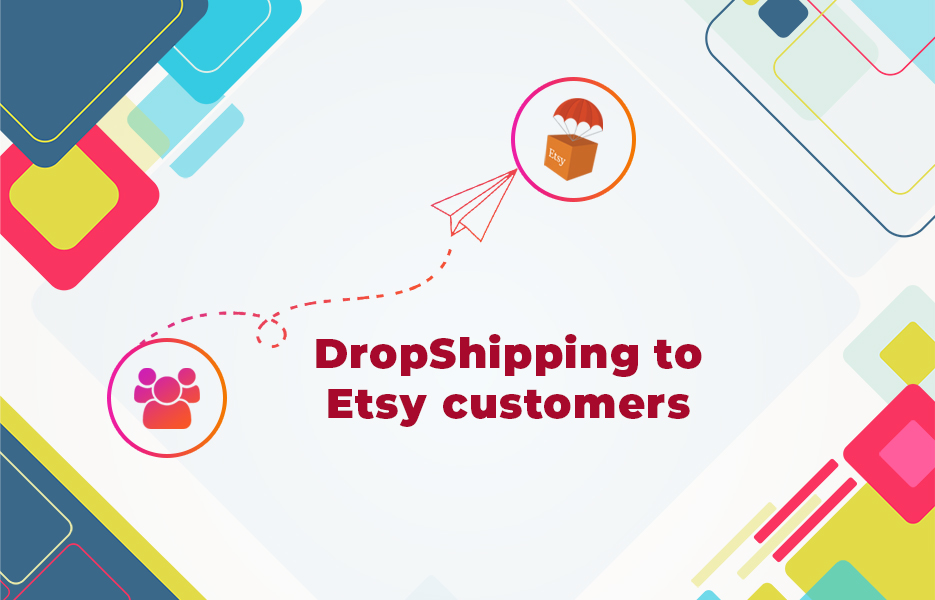
So, now we’ve covered using Etsy as a source of products, let’s look at how you can use Etsy for DropShipping.
Let’s put it very simply: you can’t use Etsy to DropShip items that you have sourced from elsewhere.
Etsy’s terms and conditions state that you cannot sell items on Etsy that you haven’t made, designed, or sourced as vintage. Reselling is not allowed apart from in the vintage (which Etsy defines to mean that items are over 20 years old – and no, ‘vintage style’ isn’t going to cut it) and craft supplies categories – so, potentially you could DropShip craft supplies, but we suspect that the marketplace is flooded. And with cheap items available from China via almost all sales channels, there isn’t likely to be a huge amount of profits to be made DropShipping craft supplies on Etsy.
Other items that are not allowed under the reselling rule include:
- Creatively repackaging commercial items (for example, a gift basket consisting of non-handmade items)
- Curating a collection of others’ handmade goods that you did not design or make
- Selling items made or designed by another seller who is not part of your shop
- Selling traditional handicrafts or fair trade items that you did not design or make
Since all of these definitions effectively cover what DropShipping is, it is best to avoid DropShipping on Etsy. If you break the Etsy terms and conditions, you’re likely to find your listings removed, and potentially have your account terminated. On top of that, if your account is terminated, you won’t get your fees refunded. All in all… DropShipping items to customers through Etsy is best avoided altogether.
However, if you have access to the right products, Etsy is an easy to use sales channel, with built-in analytics and reporting, so it is easy to manage your business.
Challenges of DropShipping to Etsy customers
Although DropShipping is essentially against all the rules on Etsy under their reselling rule, they don’t mention the word DropShipping specifically. However, there are other challenges with selling on Etsy that might impact on you, whether you’re selling your own products, or you’re still thinking about how you can try and use Etsy for DropShipping.
Opportunities for DropShipping on Etsy is limited
On reading Etsy seller policies, there is no specific mention of DropShipping, they are opposed to ‘reselling’. You’re not allowed to sell items in the handmade category that you have not made or designed. They do stipulate that you can resell in the vintage and craft supplies categories – but it is heavily restricted, and we’re not recommending that it is worth it. There are a lot of ongoing discussions online about how Etsy have defined ‘handmade’, and ‘reselling’, and many sellers are already nervous about Etsy moving the goalposts again. If you do decide to go for it and try DropShipping on Etsy, it is worth having a backup plan for those sales, in case things change and you find yourself without access to selling on Etsy.
There’s a listing fee to pay
Although setting up your Etsy store is free, you’ll pay a £0.15 listing fee (that is based on $0.20 USD, so that number goes up and down depending on the exchange rate) on each listing. Your listing is active for four months for that amount, after which time you’ll automatically be charged again if your item hasn’t sold.
On top of your listing fee, once you’ve actually sold an item, you’ll need to pay a 5% transaction fee, plus a 4% + £0.20 payment processing fee. That means that on lower priced items, you may find it hard to reach your preferred profit margins. If you’re selling handmade items from another seller through Etsy (which, again… is not allowed under their reselling rule) you’re unlikely to make many sales, since your prices will need to be higher to maintain your margins.
There is no wholesale option
For a while, Etsy were offering sellers the option to sell on the Etsy Wholesale marketplace. Unfortunately, they found the demand simply wasn’t there. The Etsy Wholesale programme did allow for sellers to sell to resellers (DropShippers), but with this closure, it’s clear that Etsy simply do not see the DropShipping model as something they are prepared to help sellers work with.
Is DropShipping from AliExpress to Etsy allowed?
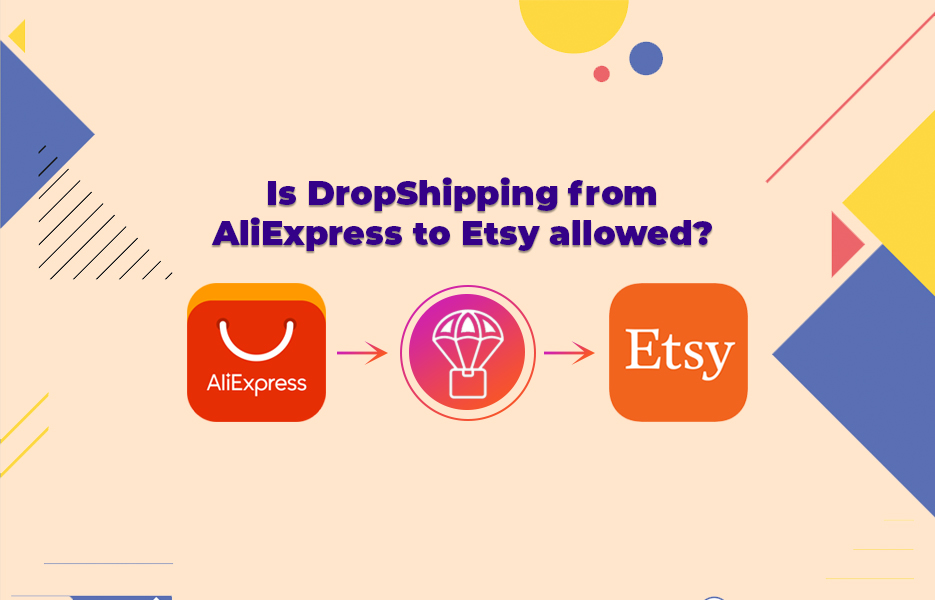
Let us repeat again: the terms and conditions of Etsy state that you cannot sell, or resell items that you didn’t make or design, or that are vintage. That means that you can’t DropShip from AliExpress, Amazon, eBay, Wish, or any other marketplace, or DropShipping platform. By doing so you will be breaking the rules, and you’re likely to lose access to your account.
What are the alternatives to Etsy?

If you find that Etsy isn’t the right platform for you – whether you’re producing your own items, you want to DropShip or you are simply looking for another sales channel – then you’re going to be looking for Etsy alternatives. These aren’t the only options available – but these are some of the biggest competitors you might want to consider.
Amazon Handmade

Amazon’s business may have started as an online bookstore, but they haven’t become a multi-billion dollar company from just selling textbooks and novels. As a company, Amazon has been moving into almost every field they can – from providing tech services through Amazon Web Services to taking on supermarkets with groceries available. So it stands to reason that the world’s biggest marketplace wouldn’t want to miss out on potentially lucrative sales revenue from artisan sellers. Handmade was launched by Amazon in 2015, to encourage artisans to sell on the Amazon platform.
Handmade hasn’t made it onto all the different Amazon stores worldwide just yet – but you can list your Handmade items in Europe on Amazon.co.uk, Amazon.de, Amazon.fr, Amazon.it, Amazon.es. In North America, Handmade is available onAmazon.com, Amazon.ca, Amazon.com.mx.
Currently, Handmade allows sellers to sell in the following categories:
Accessories, Artwork, Baby Products, Beauty & Personal Care, Clothing, Shoes & Bags, Home, Outdoor & Home Care, Jewellery & Watches, Kitchen & Dining, Pet Supplies, Sports & Outdoors, Stationery & Party Supplies and Toys & Games.
To qualify for Amazon Handmade, you’ll need to meet specific criteria:
You’re an artisan working alone, or you’re an artisan working with a group of less than 20 people. You might also qualify if you’re a collective group of artisans – either as a cooperative, a non-profit, or non-governmental organisation, or a social enterprise. Other types of artisans may be considered, but applications are considered case-by-case.
Products outside of these categories are not allowed to be sold on Handmade – including Digital or Downloadable Products, Food & Grocery items, and Electronics. If you want to sell in any of these categories, you may be able to sell on Amazon – just not in the Handmade marketplace at the moment.
However, just like sellers on Amazon, Handmade is not necessarily the best alternative for Etsy sellers. Amazon customers head to the platform because they’re looking for inexpensive items, fast delivery (usually next day) and to gain access to more items than they could ever possibly dream of. There are concerns for smaller, handmade brands that by selling on Amazon you’re commoditising your brand, and cheapening brand value.
Not only that, there is no way to link to your website when you’re selling items on Amazon, you can’t add promotional materials to customer orders (so there’s no way to advertise your website there) and you can’t use any email addresses, or contact the customer outside of Amazon. Basically – your customer belongs to Amazon, because they can’t get any information about you.
Amazon Handmade isn’t cheap either. Joining, creating a Handmade shop and listing your products are all free, but when you make a sale, Amazon takes a 12% referral fee – essentially, commission. However, if you’re listing your items on Amazon as a regular Amazon seller, if your items qualify for Handmade, it’s worth moving to Handmade, since artisans on the platform do not pay the monthly £25 Professional Selling plan fee.
If you’re wondering whether you can DropShip items on Amazon Handmade, don’t. Amazon closely controls who is allowed to sell on Handmade, and they are fully aware of users who are DropShipping on the main marketplace. That means you’d be wasting your time trying to sell DropShipped items on Handmade – even if they’re actually handmade, but by someone else.
You can find out more about Amazon Handmade here.
Aftcra

Aftcra is a marketplace for American artisans to sell their products. Customers can buy from any country, but all sellers on the marketplace have to be based in the USA. Artisans like Aftcra because it is free to set up your own shop, and there are no listing fees. Listings are valid for six months – meaning that you don’t have to keep re-adding the listing, or until the item sells, and sellers only pay a 7% transaction fee once the item has sold.
With categories covering clothing, home and furnishings, jewellery and celebrations, Aftcra is likely to be a useful marketplace if you have handmade products – made by you, and you’re based in the USA. They state that setting up an Aftcra shop usually takes less than five minutes, and there are just six steps to getting started – confirming your PayPal account, registering with Aftcra, then becoming a seller and creating your seller profile, entering your store details, then uploading your products. Easy, right?
Unfortunately for sellers who are looking for new marketplaces to DropShip items, Aftcra is not the place you’re looking for. Just like Etsy, in the Aftcra seller guidelines, it specifically states that “reselling of products that are not created by the shop owner” is not allowed. You run the risk of having your Aftcra store shut down if you’re found to have been reselling – or DropShipping, since it pretty much accounts to the same thing.
Folksy
Folksy can be thought of as the UK’s answer to Aftcra – and indeed, they have styled themselves as ‘the home of British craft’. Although around 15% of Folksy customers are shopping worldwide, Folksy only supports UK sellers. You need to be based in the UK to sell through Folksy, but if you can produce jewellery, homeware, clothing, art, wedding supplies or stationery, Folksy could be a good place for you to start selling.
It’s free to get started on the basic plan, although the basic plan is pretty restrictive – you get just three listings for free. On the basic plan, you’ll pay 6% commission, plus £0.15 + VAT on each item you sell. Pretty affordable, when you compare to Amazon Handmade’s 12% referral fee. If you need to move up, the Folksy Plus subscription will cost you just £5 a month – which gets you unlimited listings, free imports from Etsy and featured listings, as well as up to ten images per listing. You’ll still pay 6% commission, but you won’t pay additional fees on each item, so if you’re making lots of sales, this is an affordable way forward.
There’s one major bonus when you’re selling on Folksy – they don’t keep hold of your money when you’ve made a sale – unlike many of the mainstream marketplaces. All cash from your orders go directly into your PayPal or Stripe account – meaning you can use that cash immediately to keep growing your business.
Folksy does not support DropShipping on the marketplace – their terms and conditions state that “You must have made the product you are selling (unless it is a commercial craft supply), or you must be able to prove that you designed the product. Folksy supports individual designers and makers, Folksy does NOT support re-sellers.” That means, unless you’re willing to risk wasting your time and efforts for a couple of sales, it’s not worth even trying to DropShip on Folksy.
Storenvy

Storenvy is a marketplace based out of the US, and tends to feature select handmade goods. You don’t need to be based in the US, and although prices are all set in US dollars on the Storenvymarketplace, customers can order from anywhere in the world. Generally, prices are a little more expensive than on Etsy, and there are less sellers on Storenvy. However, the demographic that Storenvy is targeting is young, fashion-forward types, meaning that there is less appeal for some types of handmade items.
In addition to a marketplace, Storenvy offers sellers on their plus and pro subscriptions access to a free customisable online store that takes less than five minutes to set up. There’s a free subscription for the marketplace, with the plus plan costing $14.99 per month and pro costing $29.99 per month.
In terms of what you can sell – Storenvy state that you can decide where to source your products, meaning that there is potential for you to do DropShipping to Storenvy. Since the emphasis is still on handmade and indie brands, trying to sell items that are widely available probably won’t be that successful on Storenvy. Look at selling print on demand items, or DropShipping items that are vintage in style.
Society6

Society6 is a marketplace designed specifically for artists and creatives. There’s a community of sellers that benefit from trend reports, creative feedback and so on, with the ethos that as one succeeds, everyone succeeds. They also provide a team that can take care of producing wall art, home décor,furniture and clothing, and take care of worldwide shipping.
Artists get paid 10% of each sale, and with art prints, framed prints, and canvas prints, artists can set their own prices above the standard 10%. There’s additional opportunities to increase earnings with the affiliate programme, so sellers on Society6 who refer customers receive an extra 10% on those sales too.
Since Society6 is helping artists sell more using the print on demand model of DropShipping, if you’re a designer first and foremost, you’ll be able to earn from your designs, rather than spending time worrying about fulfilling your orders.
nuMONDAY

nuMONDAY is another British marketplace for British based creative individuals and businesses. It’s a relatively new platform, having only been established in 2016.If you’re outside of the UK, unfortunately at the moment you can’t sell on nuMONDAY, and there’s nothing to suggest that will change any time soon.
Fees are extraordinarily affordable – starting at just £90 for the whole year if you can afford to pay up-front, and £10 a month if you need to pay month-to-month. That covers the cost of unlimited listings, and there’s no commission fees – meaning that crafters and artists really can make the most of their hobby and turn it into a profitable side-hustle, or a career. There’s a transaction fee from Stripe that is applied, but this is just 1.4% + £0.20 with European cards.
When it comes to DropShipping, we’ve scoured the terms of use and the only mention that we think would apply to DropShipping is “You are responsible for maintaining that the content you submit is your own and is not owned by others.”. Since nuMONDAY places such an emphasis on handmade items, we don’t think DropShipping on the nuMONDAY marketplace will be tolerated for long.
Bonanza

Bonanza is a marketplace with an emphasis on items that are out of the ordinary. Their guidance states that their speciality is on items that aren’t shiny, new, and mass-produced. Sellers like using Bonanza to make their sales as there is so much functionality on offer on the platform, including built-in photo editing tools, product sync with other platforms and more. Bonanza also offer users the ability to create a webstore with themes – so it’s easy to lower costs and create your own brand.
When it comes to how much it costs to sell on Bonanza, you’re looking at commission– which is based on the Final Offer Value, plus shipping. For items that sell under $500, you’ll pay 3.5% of the Final Offer Value (although $0.50 is the minimum fee, so however much your item sells at, you’ll have to pay at least that amount). There are advertising features that you can use that will cost you extra, but these are optional and you don’t have to use them to be able to sell on Bonanza. You can find out more about Bonanza pricing, including examples on this page.
For sellers, there doesn’t seem to be any restrictions when it comes to DropShipping – we were unable to find any reference to DropShipping specifically, or reselling. However, there is a limit of 100,000 items for sellers who subscribe to the Titan level membership. This implies to us, that they’re happy for major sellers to be involved – and since you can access at least that many products through DropShipping platforms, you might think about using a Bonanza store, as well as listing on their marketplace.
Selling on popular marketplaces
Of course, you can sell on all the big marketplaces – Amazon and eBay – if you’re selling handmade items. But since fees on those platforms can be significantly higher, and competition much, much stiffer, then it can be harder to sell on mainstream marketplaces. Customers go to marketplaces like Amazon and eBay for the best possible prices, and so if they’re heading there, they’re not looking for an immaculately made, one-off piece.
Since it can be hard to make sales on these sales channels, it can also be hard to increase your credibility on each of them – meaning less reviews and ratings – which then feeds into how difficult it is to make sales.
With fees being higher on each item you sell, and some marketplaces charging either a listing fee (such as eBay) or a subscription (Amazon), if your focus is selling handmade items rather than DropShipping, then you’ll be looking at Etsy, and the Etsy competitors that we discussed above.
For more information about choosing your sales channels as a seller using DropShipping to fulfil orders, take a look at the blog post we wrote recently about some of the best options.
Selling on your own store
Setting up and selling through your own store has many advantages. When you take into account the fees that you can end up paying if you’re listing, or selling on different marketplaces, your profit margins can be hit pretty hard. Although you have to pay some fees for your own website – domain registration and hosting fees as a bare minimum, youdon’t have to pay monthly subscriptions, listing or transaction fees. This can save you a significant amount of money, month on month, once your customers have found their way to your website.
On top of that, you’re not at risk of breaking any rules that might risk you losing access to your account. There are no delays with receiving your payments from customers, like some marketplaces impose (looking at you, Amazon and eBay) and you’re building your brand. Building your brand is critical for your long-term success – if your customers like your products, they will come back to you again if the recognise your brand. But some of those bigger marketplaces – like we talked about before when we were talking about Amazon Handmade – don’t allow for you to make you brand known to your customers. That means whenever the customer is asked where they got something, the answer will always be the marketplace – never your business. By selling through your own website, you’re building something bigger.
But selling on your own eCommerce website isn’t without it’s challenges though. Actually building your website might be daunting if you’ve never created one before, or done any coding. You might head for an agency, only to be told your website is going to cost you way more than you thought – and that might even be the case if you look for freelancers who offer cheap website setups.
On top of that, getting customers to your website, and keeping your website up to date and secure can be a challenge in itself – which can be a drain on your time that you could be putting to better use. That’s why there are some platforms that are being established with the aim of making websites for selling art, or crafted items, much easier. Here’s a quick look at a couple that we found and thought were worth your time to look into.
IndieMade

IndieMade is a platform that offers easy to build websites specifically for artists, artisansand indie entrepreneurs. Websites take literally minutes to set up, with no dragging and dropping. All users need to do is to get their products, and their content (such as blog content) uploaded – they can be ready to sell in less than an hour. Those challenges that we spoke about, like keeping your website secure and up to date – they’re all taken care of, and there is built-in Google Analytics and reporting to help you increase your sales.
There’s a 30-day free trial, and prices range between $4.95 and $19.95. There are no listing fees – that is included in the subscription – and IndieMade don’t take commission from your sales either. You’ll need to pay transaction fees – either to PayPal, 2Checkout or Stripe – but they’re small percentages.
If you’re thinking about using an IndieMade website for DropShipping – you can absolutely use it for your online store. Although IndieMade are based in the US, you don’t have to be – IndieMade users are worldwide. Because it’s not a marketplace, it’s a website provider, you can do whatever you want – assuming it is legal to do so. They also allow you to import multiple products using spreadsheets, so if you’ve got an Excel file from a supplier, it’s easy to get started!
Big Cartel

Big Cartel is another eCommerce platform designed for artists and creatives all over the world to easily get their website up and running. It offers loads of free themes to help you get up and running quickly, but you can also customise the code if you prefer, so you can create a completely unique store. There’s plenty of functionality, including website statistics and the ability to run promotions – either from your desktop or your mobile, meaning that you can manage your business easily while you’re on the go.
Big Cartel offer you a very limited free store to start with and test drive with – allowing you to list just five products initially. Once you know it’s the right setup for you, there are three subscription packages available, based on the number of products you’re allowed to list and functionality. 25 products a month costs $9.99, and up to 300 items per month (plus more extensive functionality) will set you back $29.99.
Although Big Cartel are actively supporting artists and handmade artisans, there’s nothing to stop you from using your Big Cartel website for DropShipping. It might not be the best way to create a DropShipping focused website though, so be sure to do your testing carefully.
Choosing your sales channels
While you’re looking at different sales channels, there are a number of things you’ll be considering. We looked at this in-depth in our blog post about how to pick your sales channels, so if you’re new to eCommerce, head there for more information. As a bare minimum though, you’ll want to think about your target customer. Are they likely to visit that website? If not, is there another type of customer that you can target on that particular platform?
In addition to that, you’re going to need to check what the restrictions are for selling on that marketplace. If you’re DropShipping to customers on that marketplace, you’ll need to read terms and conditions very carefully. Even if what we’ve covered here states that DropShipping is allowed on the marketplace, it’s worth checking anyway – rules and policies get updated very regularly, and often with no warning. We will not be held responsible if there has been an update to a marketplace policy since we wrote this article and you don’t check – it is your responsibility to conduct due diligence.
Lastly, the when you’re considering the sales channels that you’re going to list your products on – whether you’re DropShipping or you are hand-making your own items, you’ll need to consider how much it costs to list your items. If you’re just starting out and don’t have money to invest upfront, a model with no listing fee, but a commission paid on the final value of the product might suit you better. If you’re confident, can invest a little up-front and you’re experienced in eCommerce, you might think about using marketplaces that use a listing fee, or a subscription model.
Whichever marketplace you start out using, we recommend considering a multichannel approach to your business, DropShipping or not. By listing items on more than one sales channel, you’re not only getting your products in front of as many potential buyers as possible, you’re also setting up your contingency plan. If, for some reason you find that your account on one of your sales channels is suspended, or there’s an issue with your setup for that marketplace, the rest of your business is can remain unaffected.
Although selling on Etsy, and any of the other handmade, or artisan-focused marketplaces might appear – at first glance at least – to be an under-used sales channel for DropShippers, generally speaking they aren’t going to be best. That’s because most of this type of marketplace are focused on handmade items, with a view to supporting artists and home crafters. If you fit into that category of seller, no doubt you’ll appreciate these marketplaces blocking the sale of mass-produced, cheap items – so your work doesn’t become cheapened.
Since supporting sellers of handmade products is the aim of these websites, they’re actively blocking sellers who are DropShipping items, to keep the focus on handmade. If you’re a seller who is DropShipping, you might find some sales through these marketplaces – but we don’t recommend it, since you’re unlikely to be able to sustain your business for long before your account is suspended. You’d be wasting your time.
If you’re considering using Etsy and alternatives to DropShip handmade products on other sales channels, bear in mind the sustainability of DropShipping these kinds of items. Since they are handmade, the makers are likely to not be producing huge numbers of each item – and you’ll need to be able to stay on top of what you’re listing, and make sure you don’t oversell. We’re not saying to discount the idea of selling items from Etsy and similar websites completely – but just to bear in mind that you may not be able to make the kind of profits you would like from it.

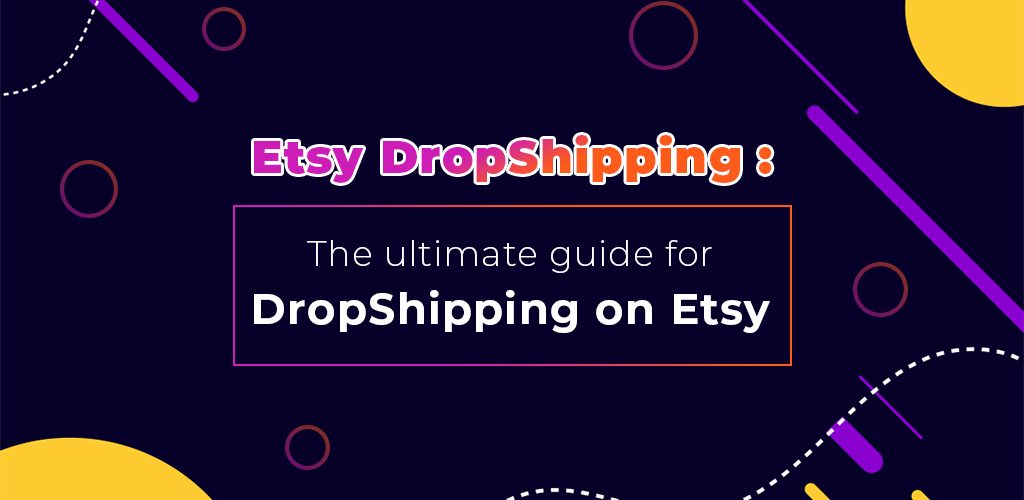


DropShip products from verified suppliers to diversify your inventory and scale your eCommerce business